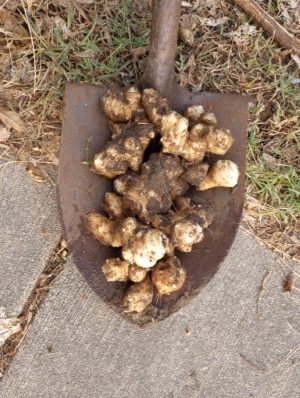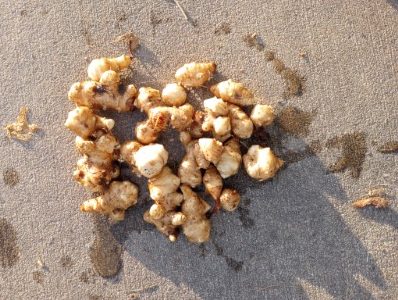Where People Come Together to Learn, Grow, and Share the Joy of Living!
Sunchokes
(Helianthus tubersosus) aka Jerusalem Artichoke
Basic Product Information Sheet – Please conduct your own research as appropriate.

We call these “Sunchokes” because Jerusalem Artichokes is harder to spell and the plant in neither native to Jerusalem nor an actual artichoke. Seems like false advertising to me. Regardless it is at least as common to call it that as it is to call them sunchokes.
We have many reasons for growing them but here are the top three:
- They are easy to grow. They practically grow themselves and in fact, can be difficult to stop growing. This leads some to grow them in places where they can be contained. They are no where near as successful as bamboo, so no need to worry to much.
- Want to grow more of them? In the fall dig up the tubers and spread them out in new areas where you want them.
- Want to grow less of them. Do not disturb the soil where they are growing, try to contain the soil in that area such that they outgrow the soil area without access to new soil.
- They are Beautiful. Blooming in late July to early August and through September in our area of Virginia, a single stalk which can reach 16ft tall can produce a massive display of yellow flowers similar to an Oxeye Daisy or Balck-eyed Susan. Sometimes they get so tall they fall over, but do not worry, all the flowers will continue to grow up vertically from the fallen stalk.
- They are Food. We haven’t talked about the scientific name (Helianthus tuberosus) yet. Helianthus means that this plant is in the sunflower family of plants. Tuberosus, means it spreads via root tubers from underground. This is why mentioned earlier enhancing or discouraging the spread of tubers is how you can influence how many plants you have. One single sunchoke plant can produce over a pound of tubers.


So, you may be wondering, how do I eat these? Well the tubers grow like potatoes and can be used much the same as you would for potatoes. That said they are smaller, probably wouldn’t make a good baked potato with chives. My favorite way to eat them is to make them into mashed potatoes, err sunchoke mash? They are also good roasted and their size can save some chop time. They can be sliced and cooked like chips or fried slices.
Why are they not the perfect potato replacement? As mentioned you are not going to make baked potatoes or long french fries out of them and, wait for it. They have a different type of starch called inulin. This can be good and it can be bad. For dramatic effect, let’s do the bad first.
Inulin has a tendency to produce gas when digested in humans, particularly when large quantities are consumed or the person is unused to consuming them. So, it gained a colloquial name “Fartichokes”. Next the good.
Inulin does not spike insulin levels, which means it can be a suitable replacement for those who are diabetic and would like a potato-like meal(s).
Here is some research.
“We concluded that inulin supplementation can significantly improve fasting plasma glucose.”
- Zhang W, Tang Y, Huang J, Yang Y, Yang Q, Hu H. Efficacy of inulin supplementation in improving insulin control, HbA1c and HOMA-IR in patients with type 2 diabetes: a systematic review and meta-analysis of randomized controlled trials. J Clin Biochem Nutr. 2020 May;66(3):176-183. doi: 10.3164/jcbn.19-103. Epub 2020 Mar 6. PMID: 32523243; PMCID: PMC7263925.

Share this post by sharing this QR code.